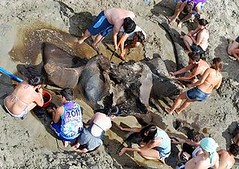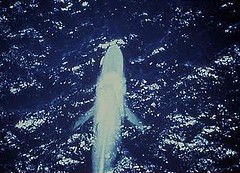 巴西聖保羅南方海灘出現的1800年藍鯨化石,這可能有助於阻止藍鯨滅絕──這種鯨魚已歷經一世紀的商業捕捉。
巴西聖保羅南方海灘出現的1800年藍鯨化石,這可能有助於阻止藍鯨滅絕──這種鯨魚已歷經一世紀的商業捕捉。
2012年8月,巴西最大城市聖保羅南方100英里外的Iguape鎮,一位當地居民在海灘上發現部分鯨魚頭骨。Ewerton Miranda de Souza在發現這些骨頭後,聯繫了巴西古生物學會,尋求聖保羅州立大學(UNESP)地層古生物實驗室協助評定及搬運。最近,其中一塊骨頭樣本的年份鑑定由美國實驗室用碳14確認,該實驗室估計這個化石的年份約為1800~1900年。
地層古生物實驗室的Francisco Buchmann教授解釋,「我們發現脊椎骨及等同於耳朵的鼓室,這有助我們來確認該物種。」他辨識出這份鯨魚骨架是藍鯨的。他強調,「我不僅認為牠可能是藍鯨,我非常確認牠就是藍鯨。」
在世界自然保育聯盟(IUCN)的瀕危物種紅皮書中,藍鯨列為「瀕危」的物種,並估計全球族群量約剩1~2.5萬頭,約為1911年族群量的3~11%。IUCN表示,近期南大西洋的紀錄到的藍鯨非常稀少。
Buchanan指出,「有傳言表示藍鯨的族群量是在增加的,不過這付化石將會明確的告訴我們答案究竟是『是』或是『否』。」
 藍鯨體長可達30公尺,重達超過170噸,是目前所知世界上最大的動物。
藍鯨體長可達30公尺,重達超過170噸,是目前所知世界上最大的動物。
Buchanan說明,今日藍鯨因捕鯨仍面臨高度威脅,尤其是來自挪威和日本的捕鯨壓力。「現在(捕鯨造成的)壓力實在太大。藍鯨需要10年、20年甚至30年才有辦法育成一隻幼鯨,如果人們獵殺了3/4的族群,可能得等上50-100年族群量才會恢復;但現在並沒有給牠們恢復的時間,年復一年的獵殺仍在持續進行。」
IUCN表示,北大西洋獵捕藍鯨行無始於1868年,並約在1900年北大西洋族群急遽下降後擴大到其他區域。在捕鯨活動停止時南極海域及北大西洋的族群量可能跌到剩下不到百隻,不過後來族群量有在增加中。
1966年起,藍鯨受到全球性的保護,但直到1972年,牠們仍被前蘇聯艦隊非法獵殺。根據國際捕鯨委員會的資料顯示,最後一次蓄意捕捉藍鯨是1978年在西班牙外海。
Buchman表示,除了該物種的保育,這次發現的藍鯨化石將有助於研究海平面變化。他解釋,「由於當時有劇烈的海平面變化,最初我認為這付化石可能有6000年。」等到年份鑑定出爐,他認為是重大自然事件(如風暴)導致骨骸化石化。
他說,「(重大自然事件)可能導致這隻藍鯨擱淺於海灘,並由於相同的事件這隻動物被迅速掩埋,因而形成化石。如果動物被掩埋,隔絕了氧氣,環境條件將使牠不會腐爛並成為化石。」
由於今日海岸的嚴重侵蝕導致這付化石被發現。「許多房子倒塌、整條街都消失了。在一棟倒塌的房子下露出了這付鯨魚化石。」
從這副鯨魚化石可回推,海洋曾經涵蓋的範圍更廣、這副化石的發現地曾被海洋所覆蓋過。
The 1,800 year old fossil of a blue whale found on Sao Paulo's southern coast may help prevent the extinction of the blue whales that remain today after a century of commercial whaling.
Last August, part of the whale's skull was found by a local resident on a beach in the town of Iguape, about 100 miles south of Brazil's largest city, Sao Paulo.
After he discovered the bones, Ewerton Miranda de Souza contacted the Brazilian Society of Paleontology asking that the Laboratory of Stratigraphy and Paleontology at the Universidade Estadual Paulista, UNESP, assess and remove them.
This week, the age of a bone sample was determined through examination by an American laboratory specializing in carbon 14 dating. The lab estimated the fossil to be between 1800 and 1900 years old.
"We found bones of the spine and took the tympanic bulla, which is equivalent to the ear. This will allow me to identify the species with certainty," explained Professor Francisco Buchmann, coordinator of the Laboratory of Stratigraphy and Paleontology.
He identified the whale bones as being from the skeleton of a blue whale, Balaenoptera musculus.
"I do not think it's a blue whale, I'm sure it's a blue whale," Buchmann declared.
In its authoritative Red List of Threatened Species the International Union for the Conservation of Nature, IUCN, lists the blue whale as Endangered and estimates a total global population as "plausibly in the range 10,000-25,000, corresponding to about 3-11 percent of the 1911 population size."
"Recent records of blue whales are very rare from the South Atlantic," says the IUCN.
"Normally, there is talk that the blue whale [population] is growing, but [with this discovery] will be possible to prove with certainty whether that is yes or no," said Buchanan.
At 30 meters (98 ft) in length and 170 tonnes or more in weight, the blue whale is the largest animal known to have ever existed.
Buchman said the species remains highly threatened today because fishing is intense, especially in countries like Norway and Japan.
"The pressure is too great. These animals need sometimes 10, 20, 30 years to make a calf," he said. If people kill three-quarters of the species, we will have to wait 50 or 100 years for these whales to recover and there's no time, because in the next year the killing will continue, he warned.
The IUCN says blue whale hunting started in the North Atlantic in 1868 and spread to other regions around 1900 after the northeastern Atlantic populations had been severely reduced. The Antarctic and North Atlantic populations were probably depleted to the low hundreds by the time whaling ceased, but are increasing.
Blue whales have been protected worldwide since 1966, although they continued to be caught illegally by former USSR fleets until 1972. The last recorded deliberate catches were off Spain in 1978, according to the International Whaling Commission.
Besides contributing to the conservation of the species, the discovery of this blue whale fossil will allow studies of the variation in sea level, says Buchman.
"Initially, I thought that the fossil would be 6000 years, because it was when we had a large variation in sea level," Buchman explains. Once the age of the bone was verified, he concluded that fossilization occurred because of a major natural event, such as a storm.
"There was something that ran this animal aground on the beach, and this same event quickly buried the animal. This favored fossilization," Buchman said. "If an animal is buried, it is isolated from oxygen, so it does not rot, it fossilizes. Environmental conditions favored it."
The whale fossil was discovered because today the beach where it was found is rapidly eroding. "Several houses fell, whole streets disappeared. Underneath one of the houses that fell, appeared this whale," Buchmann said.
Since the fossilized whale bones were discovered, the sea has advanced farther and the area where they were discovered is now under water.
{A version of this report written by Camila Maciel was originally published March 20, 2013 by Agencia Brasil, used with permission}
※ 全文及圖片詳見:ENS






